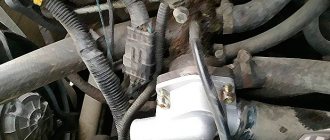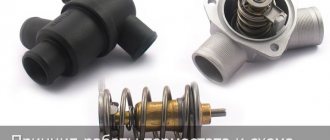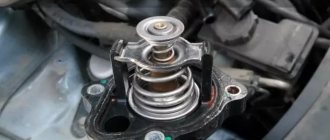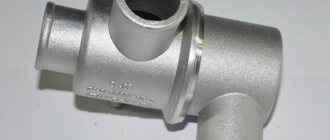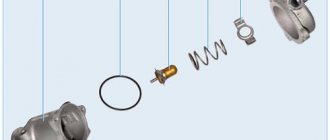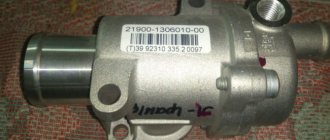Hi all! Avno has not written anything since the study session is approaching and. etc. I’ll tell you how they tortured me, I’ve already changed the thermostats 5 times, then on the large circle it jammed (does not heat up) then on the small one (it boils). The last thermos is stuck on a large circle and with the onset of cold weather in the car there is no way (it heats up all day) to turn on the oven, the temperature drops below 70.
And when you drive, so does your silence. I started collecting information about shopping at the store, comparing thermostats, and all my thoughts on how to do it better. I didn’t want to install a potama at the factory because there are a lot of connections (and the more there are, the more likely it is to leak somewhere). I wanted to install one from a viburnum (the smallest of the VAZ ones), but there, in my opinion, I need welds so that the expansion barrels can be it was possible to connect where I wanted... And welding would only take place in 2 weeks.
And I don’t like to wait and I don’t have time (it’s not cold in the car, but I have to drive). Then I took a closer look at the Priorov thermos (in principle, nothing like that) and there were no alterations. In general, I don’t like the cooling and heating system of the VAZ (huh. Full!) It always boils, so the air is not blown out, if the coolant is gone, for which the stove does not heat up well, you can give a thousand examples.
The idea is to install a thermos from a Soviet car (after all, Gineal is the simplest and easiest to use), and that’s exactly how it is on that car. If the fastenings are the same with the can, I’ll try to do it again and then I’ll write about it (well, that’s next time) - thermostat (385 rub.) (Prioress, 10.8 new sample) 6 sockets on a thermos - Alaska antifreeze 3 liters ((220 rub. ) there was antifreeze and leave it alone) - thermostat gasket (from 2-4 rubles) (place between the engine and the thermos) - pint of the Prior thermostat 2 pcs. Just in case (size M8 * 45), well, in general there is one short lower one, and another M8 * 45 upper one - expansion tube from VAZ 2112 (factory short, rigid and without thread, and from 12 - soft in thickness and thread layer, everything is suitable perfect) in principle, it’s not difficult to put everything in place.
Here I will tell you how I drained the antifreeze (the garage is not my floor, they said not the bag), but over time he needed to figure out how to drain it. And the first thing that came to my mind was that everything went fine, but the thermos tube on the stove did not want to fly out, I reported this with a screwdriver and it began to peel off like the bark of a tree shorter than the khan for it (Buy a REPLACEMENT, just in case), FROM A FRIEND I DID NOT BUY. IN THE MACHINE OF LUCK)))) I took everything apart, cleaned the space for the gasket, changed the stud, since mine came out, and it was all rusty. Lubricate the gasket area on the engine and thermos with a thin layer of lithol (a good remedy for leaks in some cases is better than sealant) and screw the thermos.
The pipe that goes to the radiator fits perfectly, but the little one from the radiator is a bit short, so he puts it on and holds it, I don’t think there will be anything bad. The pipe that goes from the thermos to the suction pipe of the pump fits yours perfectly! it all depends on the tube itself, I have a bend and straight lines and there is no need to change the tube. Then I insert the expander tube, cutting off the handle by about 5-10 centimeters (you need to look at the place) and finally the chimney, I’ll tell you, crap, these are plastic seeds! hard! wireless, I personally didn’t like it, well, there was no choice, since it was night and there was nowhere to get a replacement for the factory one. I collected everything, filled it with antifreeze and started it up.
A car thermostat for Lada Priora is a very small part that makes a big contribution to maintaining the temperature in the car. No matter how hot a car engine gets, its purpose is to reduce the temperature by circulating fluid. The price of a standard thermostat is low; as a rule, it costs about 500+ rubles. Replacing the Lada Priora car thermostat is a mandatory procedure if the car warms up. In this case, it is necessary to change the thermostat, otherwise the engine will overheat. The part has analogues, but the standard part is most effective. The Priora has 16 valves, replacement is a little more difficult, given that it is difficult to get to the antifreeze drain plug. The Priora's thermostat saves the engine from overheating. The part comes in 2 types: 1 - opens at a temperature of 92 degrees, 2 - at 95.
The thermostat on the Priora is a very simple device: very often, as a rule, what is damaged is what is inside - the cylindrical sensitive element. It is filled with a wax-based substance and therefore can withstand room temperature well. The cylinder is wound around a spring, which is attached to a valve that tightly separates the small and large circulation circles of the cooling system. When the fluid in the cylinder reaches engine operating temperature, the spring expands and “pushes” the valve outward. But this does not happen immediately: the valve is fully extended only at a temperature of 103 degrees Celsius.
When the effect of liquid cooling is achieved, the temperature (already reduced) is transferred to the filling of the cylinder, after which the spring is slowly compressed and the valve is lowered. Thanks to the funnel effect, the coolant “drains” faster and its volume remains unchanged in a short cycle - this is how the cooling system is in working condition.
The thermostat on the Prioru is set at the factory with the expectation that the engine will only operate at the maximum permissible temperature. Its design is such that the thermostat (more precisely, its valve) is designed to open at a temperature of about 98 degrees Celsius. An open valve allows coolant to flow into the radiator, so that it cools even further - to an acceptable temperature - and circulates again, only now in a wide circle.
What is a thermostat on Priora
The thermostat on the Priora is the main sensitive component of the car's cooling system. In a Lada Priora car, the thermostat is located between the engine and the radiator. Despite its small size, about 5 cm in diameter, it has two valves: bypass and main.
Replacing the thermostat on a Priora usually becomes necessary when the main valve malfunctions. It has a cylinder made of heat-sensitive material with a wax ball and rod inside. When heated above 82 degrees Celsius, the wax melts and expands, pushing the rod out. Thus the valve opens. And vice versa, when wax hardens, it decreases in volume. The valve closes. For a Priora car, the thermostat in the photo is shown in section. Its internal structure is shown.
The uninterrupted operation of the thermostat on the Priora keeps the engine temperature at a normal operating level. When the engine warms up, the Priora thermostat valve is closed, the opening temperature of which is 90-95 degrees. Accordingly, coolant does not flow to the radiator. The temperature in the system increases faster, engine wear and harmful emissions into the atmosphere are reduced, and your time and fuel are saved.
What is a thermostat for?
The car's thermostat serves to maintain normal operating temperature of the engine and protect it from overheating. Without it, the car would overheat and would not allow the interior to be heated. Also, negative temperatures would have a bad effect on the engine, leading to various malfunctions and increased fuel consumption.
The main purpose of the thermostat
Basically, the diameter of this device is no more than 5 cm. It is located between the radiator and the car engine and can be in a separate housing or built into the cylinder head. The main purpose is to maintain normal operating temperature of the engine. This happens as follows: until the engine temperature reaches 95 degrees Celsius, this device blocks the supply of coolant, but as soon as the critical point is reached, the device instantly opens the valves and the engine is cooled.
Thermostatic mechanisms regulate the temperature of the motor and, by helping it warm up faster, increase its service life, which will save the family budget. In addition, they perform very important functions in environmental terms, as they reduce the emission of very harmful exhaust gases into the atmosphere. Breakage or incorrect operation of such a part is undesirable, which means we must be able to identify the problem in time and fix it.
Thermostat operating principle
The thermostat consists of a housing and a thermoelement. The main role is played by the thermoelement. The thermocouple is built into the housing and covers one of the holes in the thermostat cover. When the temperature reaches 85 degrees, the thermoelement opens.
Direct work on the car is that when the thermoelement is closed, the coolant circulates in a small circle, bypassing the engine cooling radiator; as soon as the coolant temperature reaches 85 degrees, the thermoelement opens and coolant circulation begins in a large circle through the radiator.
So during the entire operation of the engine, the thermoelement opens and closes a huge number of times.
Thermostat operating principle
The thermostat consists of a housing and a thermoelement.
The main role is played by the thermoelement. The thermocouple is built into the housing and covers one of the holes in the thermostat cover. When the temperature reaches 85 degrees, the thermoelement opens. Direct work on the car is that when the thermoelement is closed, the coolant circulates in a small circle, bypassing the engine cooling radiator; as soon as the coolant temperature reaches 85 degrees, the thermoelement opens and coolant circulation begins in a large circle through the radiator.
Checking the Thermostat
Most often, drivers notice a thermostat malfunction during the cold season. Since a car engine at low temperatures cannot heat up to operating temperature. Based on the fact that the engine temperature is below normal, the heater will not be able to heat the interior to a comfortable temperature.
The thermostat is checked on a cold engine.
We start the engine and touch the lower radiator pipe. It should be cold, not warm, but cold is very important. When the temperature reaches 85 degrees, the lower pipe should become hot. If the check on your car shows the opposite, then the thermostat is most likely faulty.
The thermostat will also be faulty if, when starting the engine, after some time the lower radiator hose becomes warm, then most likely the thermocouple is jammed or does not completely close the large circuit.
Diagnostic methods
With a properly functioning thermostat, the car engine heats up to operating temperature in 5-10 minutes at an ambient temperature of at least 0 degrees. If warming up takes longer, then it’s quite easy to verify that the thermostat is the culprit. To do this you need:
- Start the engine and wait until the coolant temperature reading on the instrument panel is around 85 degrees.
- Open the hood and find the pipe leading from the thermostat to the radiator. It should have approximately the same temperature as the rest of the cooling system pipes. If it is significantly colder, the valve is either closed or not fully open. This is a serious reason to replace the Lada-Priora thermostat.
Reasons for failure
The operation of the thermostat largely depends on how well it is assembled. If a high-quality part is installed on the car, and the owner uses good antifreeze and changes it in a timely manner, then the thermostat can last the entire life of the car.
Unfortunately, the coolant does not always comply with GOST, and parts supplied to the conveyor undergo quality control. All this leads to the fact that replacing the thermostat on a Priora becomes inevitable.
The main reasons for failure are the following:
- Depressurization of the brass flask in which the wax is sealed. During operation, brass solder undergoes corrosion, as a result of which its integrity is compromised. This malfunction manifests itself in the fact that the valve opens completely, but is unable to close back. Antifreeze constantly passes in a large circle, and the engine cannot warm up to operating temperature.
- Foreign particles entering the thermostat. This happens if the coolant has not been changed for a long time, and has also been diluted with water, and scale has formed. In this case, the valve may become stuck in both the open and closed positions. In the first case, warming up will take longer than usual, and in the second, the internal combustion engine will overheat.
Causes of malfunction
There can be any number of reasons why a thermostat fails, but the main, most common ones are:
- scale;
- corrosion;
- dirt;
- poor quality coolant;
- spent resource.
Most often, the listed factors lead to the fact that not the entire thermostat fails, but its sensitive element, which is a sealed cylinder filled with a special wax-based mixture with a movable rod.
When heated, the mixture melts and expands, pushing the rod forward. This, in turn, pushes the valve, which closes and opens the pipeline. Corrosion, scale and dirt, settling on the moving parts of the thermostat (rod, valve), interfere with their normal operation, or even immobilize them.
What reasons can cause a malfunction in the thermostat?
The main reasons why a thermostat fails are pollutants. The latter get inside the cooling system during vehicle operation. It could be:
- corrosion of metal;
- various deposits and scale that are deposited on the inner walls of the thermoelement;
- debris and dirt.
Over time, the amount of contaminants accumulates, which becomes an obstacle to the movement of the rod inside the cooling system.
To prevent this situation, you should monitor the quality of the antifreeze that is poured into the cooling system.
Signs of trouble
Even if you do not carry out diagnostics, you can suspect the presence of thermostat malfunctions during the operation of the car. They will manifest themselves as follows:
- The engine takes a long time to warm up.
- Heating the coolant to a temperature of 130 degrees and above.
- The sensor shows the temperature during a stop is significantly higher than when driving at speed.
- The lower thermostat pipe begins to warm up immediately after the engine starts. This indicates that the valve is not closing completely.
- The lower pipe is cold when the temperature on the instrument panel approaches a hundred.
The last point reports a closed valve, except in the case when the cooling system fan is faulty, which does not require replacing the Priora thermostat.
Possible problems
Over time, the thermostat of a Priora car wears out and can be damaged. Since every time the car is started it is put into operation, the more often the car is in working condition, the more it is susceptible to breakdowns. As a result, it stops changing position and, in a broken state, takes either an open or closed position. This can be affected by mechanical damage, as well as loss of thermostat properties when the device ceases to control the temperature. It is possible that the valve will not close completely due to damage to the rubber gaskets. It is dangerous to operate such a car, so if it breaks down, it is recommended to replace the thermostat on the Priora with a new one.
The Lada Priora has 16 valves; when the device is not working, the following symptoms are noticeable on the car:
When the internal combustion engine constantly overheats, although the device is operating in normal mode, it is possible that the coolant is not passing through the radiator.
Due to coolant leakage, the device stops responding to temperature changes, and because of this, the engine will take much longer to warm up. If coolant gets on the element responsible for temperature control, the valve will open a little earlier and because of this there will be an oversupply. Thus, the cooling system may break down, and the engine will operate at higher speeds.
If the internal combustion engine starts to stall, then due to constant vibrations the coolant can come out and because of this the valve stops functioning.
How to solve a problem
Depending on the terrain in which the car is operated, it is necessary to choose which device is best to install on the Priora. If the installed device is suitable according to its parameters and characteristics, but the coolant exceeds the permissible values, then it is recommended to replace it with a similar spare part that has a higher temperature threshold for opening the valve. This approach is recommended for those who drive in mountainous areas or forests.
It happens that antifreeze stagnates in one place and this causes a plug to form. In this case, it is necessary to break through it. This can be done using a regular screwdriver.
If the valve opens prematurely, it is possible that the spring on the thermostat is weakened. In this case, you can tighten it or replace it with a new one.
When warming up the engine for a long time, it is best to check the rubber bands first. It is possible that the device is locked in the wrong position and will need to be secured in the correct position to normalize the air valve.
If the valve functions normally and opens on time, but the engine constantly overheats, then you first need to check the antifreeze level, as well as the possibility of plugging due to stagnation. It is possible that the radiator has stopped performing its functional duties and will need to be replaced. The problem may also lie in the fan or cooling pump. It is necessary to check their functionality and replace if necessary. The last thing that can interfere with good cooling is a dirty system. In this case, it is necessary to clean it.
Best winter thermostat
There are very few manufacturers of thermostats with an increased element opening temperature. One of the most reliable and best companies producing them is LUZAR. It is this company that meets all quality standards in the manufacture of its parts.
Luzar thermostats are distinguished by their excellent workmanship, and they are also tested for accuracy of operation of the element up to 100%. Therefore, when purchasing a thermoelement from this company, you can be 100% confident in its efficiency and reliability.
They are tested in special cell-baths with temperature control; response speed, reliability and efficiency are checked. All elements that do not pass inspection are rejected and sent for revision, that is, it is almost impossible to run into a defective element.
Applicability
Luzar thermostat article number: 21082-1306010-92.
This element of the system is assembled with a cover and an o-ring, therefore, replacing it will not pose any difficulties.
Its cost is from 600 rubles and above, depending on the region and store.
Such a thermoelement is installed not only on the Lada Priora, but also on other Lada cars with an injection engine. All Lada modifications on which such a thermostat can be installed are shown in the table below.
Table of applicability of the LUZAR winter thermostat
DIY replacement
Before doing the work, you need to understand whether there are any differences in replacing the thermostat on a Priora with 16 valves from the same model with 8 valves. Despite the difference in power, the differences in engines are not significant. Both are based on the same cylinder block. Only the cylinder head and the gas distribution mechanism differ, and the unit itself, in which the division into small and large circles occurs, is the same. This means that replacing the thermostat on a Priora 16 cl is no different, except that you need to remove the decorative plastic cover covering the engine.
To change the thermostat you need:
- Drain antifreeze from the radiator. To do this, unscrew the tap at the bottom and also remove the plug from the expansion tank. The container for draining must be prepared at least 5 liters.
- Unscrew the clamp of the pipe going to the radiator and pull it off. A little more coolant will leak out, so you need to place a bottle to drain it.
- Remove the opposite pipe in the same way.
- Remove the 3 thermostat bolts using a hex wrench.
- Move the rubber sealing ring from the old thermostat to the new one, lubricate the adjacent surfaces with silicone sealant.
- Install the new thermostat and tighten the bolts.
- Place the pipes in place, having previously lubricated the seats on the thermostat with silicone sealant.
Replacing the thermostat
To replace, you will need to drain the coolant.
Care must be taken to carry out work only on a cold engine to avoid burns.
Replacement Tool:
- Head or key set to “13”;
- Coolant 5 l;
- Clamps 50 mm;
- Hexagon on "6"
- Screwdriver “+” and “-”
Work process
- We remove the air filter box by unscrewing the clamp from the MAF sensor with a screwdriver and removing the chip from it. The box is held on by rubber clamps; in order for the box to be removed, you must forcefully pull it up.
- Drain the coolant. To do this, use your head or a key set to “13” to unscrew the plug on the cylinder block and drain the liquid into a container.
You can use old fluid only if it is clean; it is not recommended to refill dirty coolant.
- Loosen the front clamp of the large circle pipe on the thermostat cover (lower pipe from the radiator) and remove it.
- Loosen the rear clamp of the pipe on the thermostat cover (from the water pump tube) and remove it.
- Unscrew the 3 bolts securing the thermostat cover to the body with a hexagon to “6” and remove it.
- Install the new thermostat cover in reverse order.
- If the pipes are still old, it is recommended to use sealant to avoid coolant leaks.
After assembly, fill in the coolant, start the engine and let the car run for a few minutes, after which we check the coolant level again. Top up if necessary.
The thermostat replacement process is complete, there is nothing complicated about it.
Replacement
1. Place the car on a pit or overpass. Raise the hood and open the expansion tank cap.
2.Climb under the car and remove the engine protection. On the cylinder block we find a plug for draining the coolant in the form of a 13 bolt, it is located in the same place as on the 8-valve engine, well, due to inaccessibility from above, it is impossible to crawl up from above.
3. Place a container with a volume of at least 5 liters under it and unscrew the bolt. We wait until all the liquid has drained. Tighten the bolt.
4.In the engine compartment we find the thermostat. It is located on the right side of the cylinder head, under the air filter pipe.
5. Using a screwdriver, loosen the screws of the clamps on the two large thermostat pipes and remove them.
6.Use a hex wrench to unscrew the thermostat mounting bolts and dismantle it.
7.Before installing the new part, pay attention to the rubber gasket in the connection groove. For better sealing, you can lubricate this gasket with automotive sealant.
8.Install the new thermostat into place and secure it with bolts.
9. We put on the pipes, clamp the clamps, having previously lubricated the joints with sealant.
We recommend: Replacing the thermostat Lada 2115 (VAZ 2115)
10.Fill with coolant. If its level decreases after repair, add more.
11.Start the engine, warm it up, and check the tightness of the connections.
12.Reinstall the engine protection.
Replacing the thermostat on a Priora: instructions for the driver
“Lada-Priora” is one of the cars of the “VAZ” family. And as a typical representative, he is not without some shortcomings that arise at the most inopportune moment. Insufficient engine heating in winter or overheating in summer heat while stuck in a traffic jam - all this can be caused by a malfunction of the cooling system.
Replacing the thermostat on a Priora is an easy task for any motorist.
Purpose of the thermostat
This small detail makes a huge difference. It is the thermostat that allows the engine to operate at the optimal temperature. Being part of the cooling system, it acts as a valve that does not allow coolant to circulate in a large circle (through the radiator) until it reaches operating temperature.
The cooling system has 2 circuits that are connected to each other through a thermostat. A small circle allows you to warm up the engine as quickly as possible in cold weather. Until the coolant temperature rises to 70-75 degrees, the thermostat is completely closed. It begins to open slightly in this thermal gap and is fully open when it reaches 95 degrees.
As the valve opens, hot coolant is mixed into a large circle, where it passes through the radiator and releases some of the heat into the atmosphere. If the operating mode is violated, the Priora thermostat should be replaced.
Reasons for failure
The operation of the thermostat largely depends on how well it is assembled. If a high-quality part is installed on the car, and the owner uses good antifreeze and changes it in a timely manner, then the thermostat can last the entire life of the car.
Unfortunately, the coolant does not always comply with GOST, and parts supplied to the conveyor undergo quality control. All this leads to the fact that replacing the thermostat on a Priora becomes inevitable.
The main reasons for failure are the following:
- Depressurization of the brass flask in which the wax is sealed. During operation, brass solder undergoes corrosion, as a result of which its integrity is compromised. This malfunction manifests itself in the fact that the valve opens completely, but is unable to close back. Antifreeze constantly passes in a large circle, and the engine cannot warm up to operating temperature.
- Foreign particles entering the thermostat. This happens if the coolant has not been changed for a long time, and has also been diluted with water, and scale has formed. In this case, the valve may become stuck in both the open and closed positions. In the first case, warming up will take longer than usual, and in the second, the internal combustion engine will overheat.
Diagnostic methods
With a properly functioning thermostat, the car engine heats up to operating temperature in 5-10 minutes at an ambient temperature of at least 0 degrees. If warming up takes longer, then it’s quite easy to verify that the thermostat is the culprit. To do this you need:
- Start the engine and wait until the coolant temperature reading on the instrument panel is around 85 degrees.
- Open the hood and find the pipe leading from the thermostat to the radiator. It should have approximately the same temperature as the rest of the cooling system pipes. If it is significantly colder, the valve is either closed or not fully open. This is a serious reason to replace the Lada-Priora thermostat.
Signs of trouble
Even if you do not carry out diagnostics, you can suspect the presence of thermostat malfunctions during the operation of the car. They will manifest themselves as follows:
- The engine takes a long time to warm up.
- Heating the coolant to a temperature of 130 degrees and above.
- The sensor shows the temperature during a stop is significantly higher than when driving at speed.
- The lower thermostat pipe begins to warm up immediately after the engine starts. This indicates that the valve is not closing completely.
- The lower pipe is cold when the temperature on the instrument panel approaches a hundred.
The last point reports a closed valve, except in the case when the cooling system fan is faulty, which does not require replacing the Priora thermostat.
DIY replacement
Before doing the work, you need to understand whether there are any differences in replacing the thermostat on a Priora with 16 valves from the same model with 8 valves. Despite the difference in power, the differences in engines are not significant. Both are based on the same cylinder block. Only the cylinder head and the gas distribution mechanism differ, and the unit itself, in which the division into small and large circles occurs, is the same. This means that replacing the thermostat on a Priora 16 cl is no different, except that you need to remove the decorative plastic cover covering the engine.
To change the thermostat you need:
- Drain antifreeze from the radiator. To do this, unscrew the tap at the bottom and also remove the plug from the expansion tank. The container for draining must be prepared at least 5 liters.
- Unscrew the clamp of the pipe going to the radiator and pull it off. A little more coolant will leak out, so you need to place a bottle to drain it.
- Remove the opposite pipe in the same way.
- Remove the 3 thermostat bolts using a hex wrench.
- Move the rubber sealing ring from the old thermostat to the new one, lubricate the adjacent surfaces with silicone sealant.
- Install the new thermostat and tighten the bolts.
- Place the pipes in place, having previously lubricated the seats on the thermostat with silicone sealant.
Additional Tips
Before replacing the Priora thermostat, it makes sense to check the new one for functionality. To do this, the part is placed in a pan of water.
As you gradually heat the water, you need to watch how the valve opens. If it is completely open at a temperature close to boiling, then it can be installed on the machine.
After replacement, remember to add antifreeze to the cooling system to the operating level indicated on the expansion tank. If a certain amount of coolant was spilled during draining, then you need to add the same color as the main fluid. Antifreezes of different colors do not mix.
Purpose of the thermostat
This small detail makes a huge difference. It is the thermostat that allows the engine to operate at the optimal temperature. Being part of the cooling system, it acts as a valve that does not allow coolant to circulate in a large circle (through the radiator) until it reaches operating temperature.
The cooling system has 2 circuits that are connected to each other through a thermostat. A small circle allows you to warm up the engine as quickly as possible in cold weather. Until the coolant temperature rises to 70-75 degrees, the thermostat is completely closed. It begins to open slightly in this thermal gap and is fully open when it reaches 95 degrees.
As the valve opens, hot coolant is mixed into a large circle, where it passes through the radiator and releases some of the heat into the atmosphere. If the operating mode is violated, the Priora thermostat should be replaced.
How to quickly determine that the thermostat on a Priora is faulty?
1. Warm up the engine slightly (to about 85 degrees).
2. Open the hood. Carefully touch the radiator hose at the bottom. A cold pipe indicates that the thermostat is working properly. The liquid does not flow to the radiator at this temperature, since the Priora’s thermostat is still closed. If the pipe is hot already at 80 degrees, this indicates a malfunction.
3. Now give the engine a good run.
4. Locate the radiator hoses. They are black rubber, about 5 cm in diameter.
5. Touch them carefully (you may get burned). If any of them are cold, it means that the thermostat on your Priora car simply does not work and requires replacement.
Choosing new thermostats for cars
Since the cost of a thermostat is usually not very high, and it is responsible for the performance of an expensive engine, it is better to change it every two years.
Today you can find several types of such devices on the specialized market. The most primitive are mechanical devices. But an electronic thermostat for a car controls the temperature using a special sensor.
There are also electromechanical units that operate using contact pairs.
When choosing a thermostat, it is very important to know its temperature regime, since it differs for different brands of cars. And, of course, it is necessary to select the device only strictly according to this parameter.
Thus, thermostats for cars can be high-temperature, operating in the range of 300–1200 °C. The valve opening for medium-temperature devices occurs in the range of 60–500 °C.
There are also low-temperature devices with an operating temperature of less than 60 °C.
Replacing the thermostat on a Priora - how to spend less than an hour?
To check the functionality of the thermostat, you need to warm up the engine and turn off the ignition. After this, open the hood and find two hoses there that are connected to the radiator.
We touch them with our hand and look at the temperature sensor readings. If the latter shows that the engine is hot, while at least one of the hoses remains cold, then the “temperature guard” needs to be replaced.
To do this, you need to read the information on how to remove the thermostat.
First of all, the cap on the radiator is unscrewed and the liquid is drained from the cooling system. Then, after loosening the clamps, you need to dismantle the water pipes that go to the thermostat. After unscrewing the mounting bolts, you can remove the device itself.
Now we open its cover and, pressing the spring with pliers, pull out the sensitive element and replace it with a new one. In addition, the rubber gasket also needs to be replaced.
Now you don't know how to properly install the thermostat? But there is nothing complicated in this operation, you just need to act strictly in the reverse order.
Examination
Since problems with the device can arise at any time, the driver needs to know how to check it even in situations where it is not possible to get to a car service center.
The easiest way to check the thermostat is to leave it on. To do this, the internal combustion engine must be cooled down. We start the engine and at this time we need to touch the pipe, which is attached to the radiator. During the first few minutes, the radiator is not yet functioning, so the pipe should be cool. After this, wait until the engine warms up to operating temperature. Next you need to check the same pipe, it should be heated.
If the tube remains cold, then it is worth looking at what thermostat is used and replacing it with a similar one.
If the pipe heats up almost immediately, the engine will operate at lower temperatures. This problem is not critical, but because of this, gasoline consumption increases.
There is also a second way to check the device by dismantling it.
Before dismantling, you need to drain the antifreeze into a pre-prepared canister. After this, remove the thermostat, which is installed behind the pipe. We take the device and put it in a pan of water and put it on gas. At the same time, it should not come into contact with the walls. We lower the thermometer into the water and wait for the water to heat up to the operating temperature of the motor. When the temperature readings reach the required value, make sure that the valve changes from the closed position to the open position. If this does not happen, it is recommended to install a new device.
Replacing the thermostat on a Priora is not a complicated process that does not require special skills and can be diagnosed at home using improvised methods.
To replace, we need a Phillips screwdriver and a 10mm wrench to loosen the clamps, a 5mm hexagon, a hose, a watering can, a 5 liter bottle to drain the antifreeze, and a 1 liter bottle when unscrewing the far pipe. The leak will come from two places.
To make it easier to carry out all manipulations, remove the air filter housing (AF), take a slotted screwdriver to remove and return the rubber bands to the attachment points of the air filter housing. Next, simply unscrew the fastening nuts.
Before installing a new thermostat, check it using the methods indicated above; assembly is carried out in the reverse order.
But for more accurate diagnostics, it is recommended to contact specialized service centers that will perform their work efficiently and provide a warranty period for them.
Self-replacement of the thermostat on Lada Priora
How to replace a Lada Priora thermostat
The need to remove or change the thermostat on the Lada Priora is caused by its malfunction or the appearance of antifreeze leaks. One of the signs of a thermostat malfunction is also the engine taking a long time to warm up.
The reason for this is that the thermostat does not close the large circulation circle of the cooling system, which leads to a double increase in fuel growth when warming up a cold engine.
Or, as an option, the thermostat, on the contrary, does not open a large circle, the temperature rises to a critical level, and the engine overheats.
Causes of thermostat malfunctions
The main cause of thermostat breakdowns is corrosion, scale, and dirt that forms in the cooling system during operation. The thermoelement becomes less sensitive to changes in coolant temperature due to rust and scale particles accumulating on it.
In addition, this complicates the movement of the rod that closes and opens the small and large circles of the cooling system. To avoid such defects, you should use good antifreeze and monitor its condition. At the time of replacement, you should check the bottom for the presence of rust particles and plaque.
You can read about how to flush if there are foreign substances in the antifreeze in this article.
Checking the thermostat on Lada Priora
To confirm or refute a thermostat malfunction, it is worth performing the following test.
- We start the engine and warm it up to an operating temperature of 85-90 degrees.
- In this case, the lower radiator pipe should not heat up.
The explanation for this is that the thermostat valve is closed, so coolant does not move through the pipe. Thanks to this, the engine warms up quickly, since the coolant circulates only in a small circle.
When the antifreeze reaches the desired temperature, the valve opens, freeing access to a large circle for the circulation of coolant. As soon as the valve opens, the liquid will flow in a large circle, so the lower pipe will heat up.
If the pipe becomes hot even at a temperature of 70-80 degrees, then the thermostat needs to be replaced.
Attention!
Sometimes lack of coolant circulation is the cause of a faulty water pump, so checking it is also necessary. You can see how to do this here and here.
How does a thermostat work?
Also check out
To replace the thermostat on a Lada Priora, you will need a simple set of tools and clean coolant.
Algorithm for self-replacement of the thermostat on Lada Priora
- Drain the coolant from the cooling system by unscrewing the radiator cap.
- Loosen the clamps that secure the water pipes leading to the thermostat and remove them.
Changing the thermostat on Lada Priora
- Unscrew the thermostat mounting bolts and remove it.
- Remove the housing cover by unscrewing the fastening bolts.
Do-it-yourself replacement of the Priora thermostat
- Remove the rubber gasket located on a certain recess of the thermostat cover. Make sure that its condition is good, otherwise replace it.
Replacing the Lada Priora thermostat at home
- Get the mod (sensitive element). To do this, you need to squeeze and rotate the spring with pliers and remove the fixing plate from the hook with the grooves.
Thermostat Lada Priora
- Check the new mod before installing. This is done as follows: put it in water and heat it. At 85-90 degrees the thermostat rod should move out; if this does not happen, the sensitive element needs to be replaced.
How to check the thermostat at home
Recommendations: You can completely replace the thermostat without disassembling it. It will cost more, but it is easier to do.
After replacing the Lada Priora thermostat, you need to fill in clean antifreeze and reassemble in the reverse order. After this, start the engine and check the operation of the thermostat (the test algorithm was described earlier). Make sure there are no leaks.
How to check the thermostat
You can understand that the thermostat has stopped functioning normally by the time the engine warms up. If the coolant does not heat up to a temperature of 90C within 5-10 minutes of engine operation, then it’s time to check the thermostat for functionality.
The opposite can also happen - the engine heats up quickly, but the temperature reaches critical levels. This indicates that the thermostat valve is constantly in the closed position.
There are two ways to check the thermostat. The first method does not require removing it from the engine. To check you need:
- start the engine;
- warm it up to operating temperature;
- raise the hood;
- Find the lower radiator hose and touch it.
If the pipe is cold, it means the thermostat has not worked. If it is hot (warm), the device operates in normal mode.
The second method will not only determine the functionality of the thermostat, but also clearly show its operation. To do this you need:
- remove its cover along with the sensitive element;
- put it in a metal bowl with water and put it on fire;
- heat to a temperature of 85-90 degrees.
The sensing element rod should move forward. If this does not happen before the water boils, the thermostat can be thrown away.
What is the best thermostat to install on Priora - analogues
A regular retail parts store can offer analogues of the thermostat for Priora from the following manufacturers:
- Stellox;
- luzar;
- Gallant;
- FENOX.
In the question of which part is better to choose, it is hardly possible to compare analogues - they differ in quality. When asking drivers what thermostat is installed in their car, the most common answer is that only the original one is installed. It’s easier to trust the manufacturing plant - they know what they’re dealing with.
Standard part - article number, price
The thermostat for the Lada Priora car is produced not only by the Volzhsky Automobile Plant - there is
economical analogues, not at all pleasant in terms of quality and durability. Compared to them, the price of a thermostat for a Priora with a 16-valve engine is not very high - about 500 rubles.
Many people adhere to the theory that even an analogue can be better than the original; the main thing is to look good. The article number of this part for Prioress must contain the following numbers - 21082-1306010-10.
Replacing the Priora thermostat is required if the following symptoms occur:
Unfavorable factors such as dirt in the coolant, scale, corrosion and metal flakes can cause the moving parts of the valve to stop working properly. It may also jam. The following signs may indicate this:
• The coolant temperature rises to operating level too slowly, taking longer than 10 minutes. This makes it clear that the valve is always open. Therefore, the coolant, circulating in a circle through the radiator, does not allow the engine to warm up.
• The engine heats up quickly, but the temperature becomes critical. This happens when the valve is closed, blocking the flow of coolant to the radiator.
Therefore, when choosing which thermostat is best for a Priora, do not forget about the coolant. It must be clean and of good quality.
How to replace a thermostat on a Priora
In order to successfully replace the thermostat in a Lada Priora car, you need to prepare. You should have clean coolant and tools on hand: a Phillips screwdriver, narrow-nose pliers and a five-point hex.
On a Priora car, the thermostat is replaced using the following algorithm:
1. Unscrew the cap on the radiator and drain the coolant.
2. To remove the Lada Priora thermostat, you will first have to loosen the clamps and disconnect the hoses that are attached to the thermostat cover.
3. Having previously unscrewed the bolts, remove the thermostat (Photo of the Priora and its engine compartment - see below).
4. Remove the thermostat cover bolts and pull it out.
5. Inspect the gasket located in the annular groove of the cover. If it is worn out, replace it.
6. Using pliers, pull out the mod. To do this, carefully clamp it, turn it and remove the fixing plate from the grooves.
7. We check the functionality of the new mod: heat it in a container with water. The pin should extend when the temperature reaches 90 degrees. Is this not happening? This means the mod is faulty.
8. We assemble the new thermostat in the reverse order. Do not forget to coat the joints of the pipes and the gasket on the cover with automotive sealant.
9. Pour clean antifreeze into the expansion flank of the engine up to about.
10. Warm up the engine, checking for leaks.
The price of a Priora thermostat fluctuates around 500-1000 rubles. When choosing which thermostat is best for Priora, focus on workmanship, not cost. The new thermostat will allow the Lada Priora to delight you with uninterrupted operation.
Which thermostat is better to install on Priora
In order not to be tormented by the question of whether it will fit or not, it is much better to buy a standard Priora thermostat, the catalog number of which is 21082-1306010-10. Various analogues should not be used.
As a last resort, you can take a VAZ branded part from other car models. Check with the store that you are choosing a thermostat for a Priora. An experienced sales consultant will tell you which one is better.
In addition, the correct choice will be facilitated by knowing at what temperature the thermostat on the Priora opens. Starting to open at 83 degrees, the rod fully opens at 102 degrees Celsius. Take this into account when deciding which thermostat is best for the Priora if you decide to install something different.
Cost of replacement work
The standard thermostat of the VAZ 2170 Priora has catalog number 21082-1306010-10. When replacing, it is best to use a branded VAZ part, bypassing various types of analogues. As an alternative, you can use thermostats for other VAZ models with the following catalog numbers:
- 21082-1306010-11;
- 21082-1306010-12;
- 21082-1306010-14;
- 21082-1306010-15.
The thermostat is supplied with a 5mm hex key.
To be sure that the purchased thermostat is working, it is recommended to test it in hot water using the method described above before installing it.
We recommend: Is it possible to ride on Velcro in the summer?
The cost of a thermostat for a VAZ 2170 is about 500 rubles. The price for replacing it at service stations varies from 500 to 800 rubles.
How to check for functionality
If all the described actions are not enough to determine the condition of the part, you can resort to experiment. As written earlier, to start working the part you need to feel the temperature of about 93-95 degrees. Why not replace the coolant with water?
The experiment can be carried out anywhere there is a kettle. After pouring approximately 300 ml of boiling water into a cup, you will have to wait 2 minutes, and then lower the “test person” into hot water. If it is working, then you can clearly study the principle of its operation. The rod of the part will begin a kind of movement, and the valve will rise to open the fluid communication through the large cycle.
Replacing the thermostat is not the easiest repair operation, but it is necessary so as not to “boil” in a traffic jam. It all depends on the choice of part and priorities. If you are too lazy to change it on time, engine wear will increase and, accordingly, its life will decrease.

